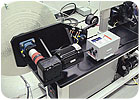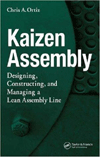Engineers can use web handling technology to feed thin, flexible materials in high-speed automated assembly systems.

A web-handling device feeds material for a diagnostic test strip into a high-speed automated assembly system. The system can assemble 120 test strips per minute. Photo courtesy Production Assembly Systems Inc.
A web is a continuous strip of flat, flexible material or thin, interlinked parts that is fed into-and sometimes out of-an automated assembly system on reels or rolls, says John O’Hara, director of sales and marketing at Cox Automation Systems (Bloomingdale, IL). Many materials are supplied on webs, including pressure-sensitive adhesives, labels, decals, filter media, foils, flexible circuits, textiles and plastic films, such as polypropylene and polyethylene terephthalate (PET). Web-fed materials are found in home products, hardware assemblies, consumer electronics, medical test strips, transdermal drug delivery patches and energy storage devices.
In some cases, web handling is a subtractive process: That is, parts are cut or removed from the web and added to an assembly. To facilitate removal, the material is often partially die-cut. In other cases, as with flexible circuits or adhesive-backed assemblies, web handling is an additive process. Parts are added to the web as it indexes through the assembly system, and the web acts as its own conveyor. In still other cases, the web-fed material is contained in the assembly, but isn’t structurally part of it, as with photographic film cassettes.
“The web can move through the machine in a continuous motion,” says O’Hara. “More typically, the web is used as a carrier for discrete elements, and it will index a certain number of pitches each cycle so that something can be done to those elements.”
Since webbed parts are already singulated, oriented and precisely located, web handling is easier than feeding loose parts from a vibratory bowl. However, that’s not to say web handling doesn’t have its own unique challenges. “Handling a web is like pushing a rope,” says Ervin D. Fringer, program manager for Remmele Engineering (St. Paul, MN).
The rollers that pay out the web and take it up again are servo-driven. O’Hara advises engineers to adjust the roller speed and indexing speed so there’s some slack between the reel and the assembly machine. Decoupling the payout process from the assembly process is important, because the diameter of the reel-and therefore, its inertia-changes over time as material gets used up. “At start-up, you want to load a fairly substantial reel in the machine, so you’re dealing with a good deal of inertia,” O’Hara explains.
In the assembly zone, the web should be taught, but not so tight that it stretches. This will help to verify and maintain the position of the web both vertically and horizontally. Sprockets or clamps control the web in the assembly zone. If necessary, a vacuum can be applied beneath the web to ensure the material lays flat for processing. Machine vision can be used to inspect the web and orient actuators to fiducial marks.
The repeatability of one pitch to the next is critical. Registration marks are particularly important on homogenous web materials. Such marks act as mile markers along the web. “Engineers should make sure their web suppliers maintain registration tolerances,” says Fringer.
It’s also a good idea to control temperature and humidity inside the machine. Excessive heat can alter the flexibility of the web material. Too little humidity can cause a build-up of static electricity, causing the web to stick to handling devices.
One example of an automation system that included web handling was recently built by Adaptive Equipment Inc. (Gainesville, FL) to assemble anti-theft tags for consumer products. A SCARA robot picks magnetic metal strips and places them on a web of pressure-sensitive adhesive. The end effector is a vacuum tool with 72 pairs of vacuum cups. The motion of the web is controlled by servo indexing and pneumatics. Machine vision registers the robot with the web after each index. The system assembles 20 tags per second.






